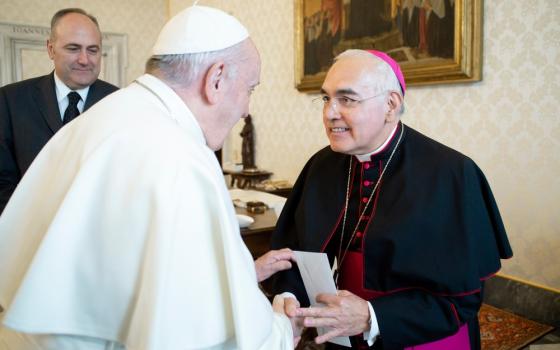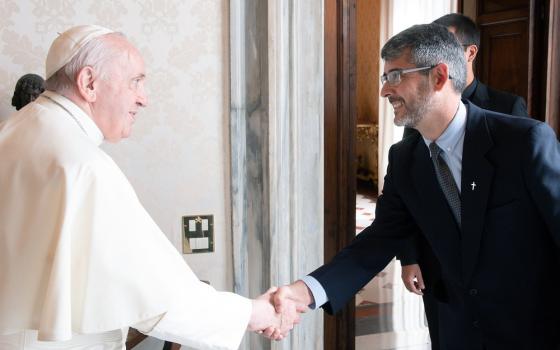The Vatican's sterile announcement of Bishop Robert Finn's resignation was a typical but unsuccessful attempt by the Holy See to sanitize the harsh reality of a failed bishop. It was a removal disguised as a resignation. The absolute need for accountability of bishops would have been far better served had Finn been publicly removed rather than offered the thin camouflage of resignation.
The reason for his resignation in the oblique canonical language of the announcement was his inability to continue to fulfill his office because of "another serious reason" (canon 401.2). Much of the media focus was on Finn's 2012 conviction of failure to report Shawn Ratigan, a Kansas City priest who had child pornography on his laptop. There's a lot more to it than that. Whether Finn was an overall effective leader was the main point that Archbishop Terrence Prendergast, the Vatican investigator, looked at. One of his worst failures as a leader was the disastrous way he handled clergy sex abuse cases. This is the other chapter of the story.
Between 2005, the year Finn was appointed, and 2015, there have been at least 94 cases filed against the diocese. Some of these involved allegations of serious sexual abuse that goes back decades -- abuse covered up and mishandled by Finn's predecessors. In many cases, Finn was not part of the cover-up because it was all out in the open by the time he arrived. His failure, the extent of which cannot be understated, was in the way he responded to the victims who resorted to the civil courts. And, as an aside, the main reason most victims have gone to the civil courts is because they have been denied any justice, support or deserved compensation by the church's administration.
Finn pretty much ignored victims. In his 10 years as bishop, he met with two and possibly a couple more, but not to extend pastoral care. His meetings with victims were all part of legal proceedings. From all sources queried, there is no evidence he ever reached out as a caring shepherd to any of the people whose lives had been ravaged by the Kansas City priests.
He did his dirty work through his lawyers. Although some bishops when asked about the toxic antics of their attorneys try to dodge the issue by claiming it was the lawyers and not them, the cold fact is that the bishop hires the lawyers, sees that they get paid, and approves their strategies. Unlike the victims' attorneys, who are paid on a contingency basis, the church's lawyers are paid by the hour whether they win or lose. The lawyers for the Kansas City diocese were paid a lot under Finn's reign.
Then we come to the long, ponderous journey of some of the abuse cases through the legal system. The victims' attorneys, basically one firm, were faced with a constant barrage of motions, deposition notices and other legal roadblocks to prolong the inevitable. The only winners were the lawyers, and the major losers were the laypeople of the diocese who actually provided the money through donations to pay for Finn's campaign against the victims.
The legal costs to the diocese are in neighborhood of $24 million. Included in this amount is a fine of $1.1 million imposed by the court because the bishop failed to honor some of the terms of one of the settlements. He, and consequently the diocese, agreed to do certain things that they intentionally failed to do. The people of the diocese paid for it.
I was an expert witness in some of the civil cases. At the end of some of my reports in the section of expert opinions, I wrote, "The diocese has continued to re-victimize the victims and to harass their families by means of a protracted legal process." The defense lawyers never challenged me on this during my seemingly endless deposition. It was true. Hiding behind the abuse of the legal system looked like a safe way to clobber the victims without being blamed, but it didn't work.
The harassment came in a number of forms. I was deposed in one case, a case of wrongful death brought by the parents of a 14-year-old boy who had committed suicide after being sexually abused. In that case, the defense lawyers took 200 depositions and filed approximately 2,000 motions, many of which were motions for dismissal. This was an incredible waste of money and time, especially since the diocese settled the case for more than $2 million.
One of Finn's staunchest defenders has been Bill Donohue of the so-called Catholic League for Civil Rights. Donohue held a rally in Kansas City in defense of Finn in 2011. This was when Finn was on trial for failing to report suspected child abuse. Donohue proclaimed, "There was no complainant and no violation of law."
For the nonviolation, Ratigan was sentenced to 50 years in prison, and Donohue revealed another level of his ignorance about child abuse. A month later, he attacked Jon David Couzens, an abuse victim. Couzens brought a suit against the diocese that ended in a settlement. Donohue called it a "soap opera yarn" and branded Couzens not only a liar but said he had been implicated in a "drug-related murder." One of the victims in this "soap opera yarn" was the young boy who took his own life at age 14 after being sexually assaulted. Imagine how his parents felt when they saw their son's abuse referred to in such derisive and dishonest terms.
Couzens sued Donohue for defamation. The case was dismissed not, as Donohue erroneously reported in a recent news release, because it was "bogus." It was dismissed because it was filed in the wrong state. The reason had nothing to do with the substance -- but then, accuracy and facts have never been a barrier to Donohue's rantings.
Donohue's credibility is close to zero, so ordinarily, I would not waste a sentence on him. However, many people make the egregious mistake of thinking he speaks for the Catholic church. His regular ravings against the victims of clergy sex abuse could be dismissed as such by most people, but they are deeply hurtful to the victims and their families, who were suffering enough without having Donohue spew his venom on them.
Finn could have stopped Donohue, but he didn't. Over the years, Donohue has expressed great concern for doctrinal orthodoxy and obedience, which appear to have supplanted basic Christian decency and charity.
Another sad chapter in the Kansas City leadership vacuum was Finn's unsuccessful campaign to close down the Survivors Network of those Abused by Priests, the world's oldest and largest survivor support organization. He did this in cahoots with Cardinal Raymond Burke of St. Louis and Burke's successor, Archbishop Robert Carlson. They had their lawyers try to force SNAP to disclose confidential communications with victims. SNAP had to defend itself in the legal arena, and this was costly.
The lawyers' game plan was to accomplish what the bishops hoped for; namely, the hastening of SNAP's demise by draining its resources through useless litigation. SNAP was not a party to either of the cases used as launchpads for this legal maneuver, but that didn't matter: SNAP is a threat to the bishops, so it had to be snuffed out. The outcome: Finn and Burke have both been sidelined by the pope, and SNAP is still standing. So who was on solid ground in that dispute?
The real hero in that nightmare was SNAP's national director, David Clohessy. He withstood the withering attacks of the lawyers; he protected the victims' privacy; and he survived the vicious and dishonest attacks on him personally and on SNAP by Donohue.
While a few have suggested that Finn was ousted for ideological reasons, nothing could be further from the truth. Finn had to go, not because he is an ecclesiastical conservative who tried to take the diocese backward in time and re-gild the monarchy, but because he either forgot or never fully realized that when Christ referred to "the least of my brothers," he was referring to those most debased and rejected. In the church of Kansas City, the "least" were those who needed Christ's love the most: the people violated by the church's own priests.
[Dominican Fr. Thomas P. Doyle is a canon lawyer and longtime advocate for victims abused by Catholic clerics. He is also co-author of the 2006 book Sex, Priests and Secret Codes: The Catholic Church's 2,000-Year Paper Trail of Sexual Abuse.]




